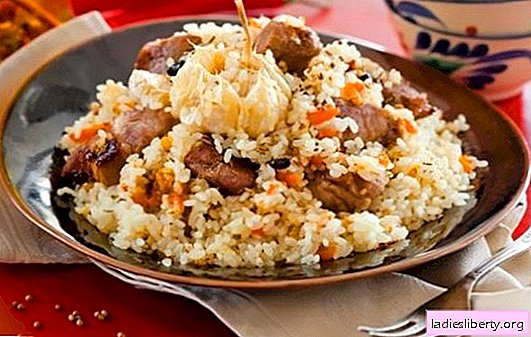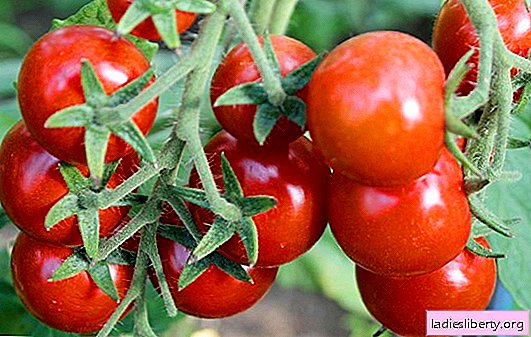
Pilaf is a traditional dish of Central Asian cuisine, prepared according to all its canons only from lamb and always above the coals. But this does not mean at all that this dish cannot be prepared differently.
With a specific aroma and taste, lamb can always be replaced with pork, a large vat with a smaller cauldron, and a bonfire with a home stove. Pork pilaf, cooked at home, is in no way inferior to the traditional dish, if all the cooking rules and the recommended proportions of not only water to rice, but also products are strictly observed.
Once having cooked pilaf with pork according to the step-by-step recipe described in detail below, even an inexperienced cook can proudly say that he learned how to cook pilaf correctly.
General recommendations and technological principles for preparing delicious crumbly pilaf with pork according to a step-by-step recipe
• To cook pilaf, metal (not enameled) thick-walled dishes will be required. In nature, pilaf is cooked in a large cauldron, at home its smaller copy is used. If there is no small cauldron, it can be replaced by a ducklings or even a cast-iron frying pan, the main thing is that its walls are high enough.
• Properly selected dishes are not everything. Not any kind of rice is suitable for pilaf. Very often in the market from sellers of spices you can buy weighted rice grown in Central Asia. The best for pilaf from Central Asian rice varieties is considered to be "Devzira". It has large grains with a slight pinkish tint. Unlike factory rice packaged in batches, it is sold not washed, so before use it must be thoroughly washed to wash off the powder from the grains. Also on the market you can find subspecies of this variety of rice. The most common is Dastzar-Sartyk, the least common are Kenzhov and Arpa Shaly. These are exactly the varieties that are grown in Central Asia. As for the rice varieties familiar to us. To obtain loose pilaf, take "Jasmine" or "Basmati". It is not recommended to take round-grain rice for such a dish. Their increased starchiness will not allow you to cook friable dishes, even if you strictly follow the recommendations for cooking pilaf with pork in a step-by-step recipe.
• A rice variety selected according to recommendations is not all. Pay attention to the surface of the grain. It should not be smooth, light ribbing should be visible on the shell. Try to crack the picture, if you make it easy and the grain crumbled right away, refrain from buying. This cereal will make meat porridge, not pilaf. Packed rice should be purchased only in transparent packets in which you can clearly see the cereal. Its grains should not be crushed, and the presence of litter indicates poor-quality processing.
• Before use, be sure to smell the cereal; it should not have a sharp repulsive smell.
• Real Central Asian pilaf made from lamb. But if you replace such meat with pork and follow all the rules described in a step-by-step recipe for pilaf with pork and choose the right meat, then the dish will turn out to be no less tasty and quite appropriate to the Central Asian canons.
• For pilaf, it is better to take pork ribs, or pieces of flesh pulp - neck is the most suitable part of the carcass. Ribs are cut along the bone, large ribs are cut. The pulp is cut into large or small pieces of square shape. It is preferable that the size of the pieces does not exceed four centimeters.
• The whole process of cooking this pilaf consists of several stages: warming the oil, cooking zirvak from meat and vegetables, laying rice with water topping and bringing pilaf to readiness. The technology of each of the steps is described in the recipe for pilaf with pork below, step by step.
Pilaf with pork: a step-by-step recipe for a Central Asian dish at home
Ingredients:
• pork ribs or neck - 600 gr.;
• two large carrots;
• 400 gr. long grain rice;
• three onion heads;
• refined sunflower oil;
• two small heads of garlic;
• set of spices "For pilaf".
Cooking method:
1. To rice steamed in pilaf evenly, it must first be soaked in salted water. First of all, we sort through cereals. We select from it all extraneous impurities, remove damaged spoilage and fragmented rice. Then we wash the rice with cool water until clean, and transfer the cereal into a bowl. Separately, in one liter of filtered water, dissolve a teaspoon of salt. Pour the solution to the rice and leave. After two hours, rinse the grits and leave on a sieve or in a colander.
2. In cool water, wash the meat. If you took a strip of ribs, cut into the flesh between the bones. Cut large ribs. Calculate so that you get pieces no longer than 7 cm. The flesh is cut into square pieces no larger than 4 cm, you can slightly smaller. Prepared meat needs to be dried; otherwise, hot fat will be sprayed upon contact with it - we wipe the pieces with a paper towel.
3. We prepare vegetables. Peel the onions and carrots. We remove only the upper layers of the husk from garlic, do not remove the dense shell covering the prongs and do not disassemble the garlic, the heads should remain whole.
4. Cut the carrots into thin strips. Many people prefer to grate it on a coarse grater - it's faster. But for pilaf, carrots are preferable to cut. When adding grated vegetable, not only the type of dish changes, but also the taste. We chop the onion in half rings or rings, 2 mm thick.
5. We put the cauldron on the stove, turn on moderate heating - slightly below average. Warming up the tank for about a minute, pour vegetable oil into it with a layer of one and a half centimeters. Reduce the heat a little, slowly overheat fat - the oil should not boil. We warm until a whitish haze appears above its surface. The degree of hardenability of the oil can be determined by salt, if you throw a few large crystals into it, they should crack and bounce off its surface.
6. When the oil is sufficiently hot, increase the heat to the maximum and carefully, so as not to get burned, lower the meat into the cauldron. Intensively mixing, bring the pieces to brown. The meat should not be stewed, otherwise it will become dry and not tasty. It is the rapidly forming golden crust that seals in pieces all the juice that does not go away from them in the future.
7. The meat is flushed, add the onion and reduce the heat a little. Cooking stirring, not allowing to brown. To the onion that has reached transparency, we add carrots. We cook everything together, without changing the heat, and also systematically mix so that the zirvak does not burn and does not stick to the walls and bottom of the cauldron. When the carrot becomes soft, slightly reduce the heat and continue cooking until it becomes more saturated in color.
8. In the finished zirvak, about half an hour after laying the meat, lay the peeled heads of garlic, add spices. They are put in quantity at the rate of one and a half teaspoons on a pound of dry rice. Therefore, we need to put a little less - a teaspoon and about a third of it. Adding spices, add salt to the zirvak and add 100 ml of hot water to it. Stew on low heat for about a minute.
9. We level the prepared zirvak so that it completely covers the bottom of the cauldron. We spread on it dried, swollen in water rice. We also level it, after which we slightly ram. We do this carefully, in no case should cereal mix with zirvak. Rice should lie on it with a thick uniform layer and not touch the bottom of the cauldron in any way, otherwise it will stick to it.
10. Add hot water. Pour it onto the surface of the rice layer carefully so that it does not violate it, slightly add salt. The amount of liquid should be equal to the weight of the swollen rice. For one kilogram of dry cereals, 2l100 ml of water is taken, taking into account added to the zirvak. For swollen rice soaked in water, you need to take 30% less liquid, in this case, approximately 600 ml of boiling water will be required. To make pilaf crumbly, the rice layer should be covered with water and a half centimeters.
11. After that, for aroma, you can put a little anise or barberry in the pilaf, if they are not in the previously added spices. You can also add a little washed dried apricots. Five dried apricots will be enough for a given amount of rice.
12. After laying the rice and adding water, on an intense fire, bring the pilaf to a boil. Then we reduce the heat so that the water only boils slightly, close the cauldron very tightly with a lid and continue cooking. Before boiling, you can add a little turmeric to the water, it will give rice a pleasant golden-lemon tint.
13. When all the water has evaporated, collect the rice in the form of a slide, pierce its surface in several places, preferably with a wooden stick. Close tightly again and bring to readiness at the very minimum fire, for 20 minutes.
14. The finished pilaf, after turning off, must be allowed to rub. Mix the pilaf well, wrap the cauldron for half an hour in a blanket.
Tricks of cooking and useful tips for a step-by-step recipe for pilaf with pork
• Be sure to go through the pic. In addition to litter and damaged grains, select defective, crushed rice. Their presence will negatively affect the appearance of the dish, it will more resemble friable porridge than pilaf.
• It is not necessary to soak the cereal in water. But it is worth noting that when using dry rice, pilaf will cook longer and if the cereal is poorly washed, crumbly dishes will not work. When soaking, rice not only swells, excess starch comes out of it.
• Never mix different varieties of rice; they will not be steamed evenly. It is also not recommended to mix cereals and one variety, but purchased at different times, not from one batch.
• When pouring water, in order not to disturb the rice layer, use a wide slotted spoon, a stream of water directed at it will be sprayed in different directions, and not pour in one place.
• If the lid does not fit snugly into the cauldron, wrap the towel around the towel and lay it in a circle, completely covering the gap. From above, for reliability, you can put a kettle filled with water, it will press the lid more tightly to the cauldron.
• When cooking pilaf with pork according to a step-by-step recipe, strictly adhere to the technologies of each step, observe the recommended heating of the stove, be sure to wrap the cooked pilaf for a while and then the dish cooked at home will not be inferior to the traditional one.











